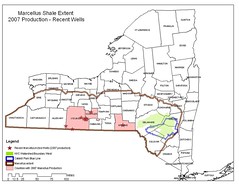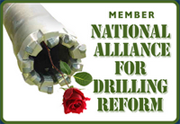When the nation’s largest oil and gas exploration and production company offered its support for making the chemicals used in hydraulic fracturing public, concerned U.S. residents who want transparency got perhaps their biggest boost from a somewhat unlikely source.
In a U.S. Securities and Exchange Commission filing, Irving-based ExxonMobil Corp. said it would support the disclosure of chemicals used in hydraulic fracturing. ...the injection of millions of gallons of water, sand and chemicals – so far not publicly disclosed by oilfield services companies – into the ground to break up porous shale and allow for enhanced recovery of natural gas and oil.
“ExxonMobil supports the disclosure of the identity of the ingredients being used in fracturing fluids at each site,” according to the April 13 filing. “While we understand the intellectual property concerns of service companies when it comes to disclosing the proprietary formulations in their exact amounts, we believe the concerns of community members can be alleviated by the disclosure of all ingredients used in these fluids.”
The company’s stance is seen as a move aimed at curbing possible federal regulation of fracing, which so far has been overseen by state agencies, such as the Railroad Commission of Texas. ExxonMobil’s statement also echoes similar stands by two other companies: Chesapeake Energy Corp. and Range Resources Corp., whose top executives last year offered their support for disclosure.
Although several big names support disclosure, transparency isn’t their decision to make. The oilfield services companies perform the process for the operators, and therefore must choose to make the chemicals public information, which isn’t likely.
...
The top three firms – Halliburton, Schlumberger and BJ Services Co. – either did not return multiple requests for comment by the Business Press’ time of publication or skirted the question of whether they would consider disclosing the chemicals used.
ExxonMobil can’t force services companies to disclose, said Lisa K. Vaughn, a partner in the Fort Worth office of Shannon, Gracey, Ratliff & Miller LLP, “but as they and the other bigwigs of the world put more pressure on the suppliers to disclose that might lead the,” push toward disclosure.
Operators “are beginning to feel legislative pressure against their potential environmental contaminants,” she added...
Insistence on safety
A driving force behind the move toward disclosure is public pressure.
“Part of what’s going on is this recognition by the oil and gas companies that there’s this fear by the public about what’s in the frac fluid, and this fear is caused by not knowing,” Vaughn said.
Despite public fears, the Railroad Commission of Texas insists the process is safe and effectively regulated.
Yadda yadda yadda:
“Even with the recent intense hydraulic fracing activity in the Barnett Shale of more than 13,000 gas wells, there have been no documented cases of groundwater pollution caused by fracing in Texas,” said Ramona Nye, a commission spokeswoman. “One reason for this is that the commission has strict well construction requirements that require several layers of steel casings and cement to protect groundwater. Another reason is that most of the fracing that is occurring, such as in the Barnett Shale, for example, occurs in geologically confined formations that are more than a mile deep. In contrast, the groundwater in the Barnett Shale region goes no deeper than 500 feet.
Meanwhile...
Although the Texas officials say no contamination has yet occurred, last week, about 135 Caddo Parish, La., families were evacuated after an EXCO Resources Inc. drilling crew reported “irregular pressure readings and signs of natural gas in the air” at a well site, according to KSLA-TV, a local news organization. Two wells of the three wells at the Dallas company’s site were cemented shut as a result; however, testing of private water wells also revealed at least 10 wells contaminated with natural gas, according to the Louisiana Department of Environmental Quality.
Little data available because chemicals untracked
The Railroad Commission of Texas does not require operators to list the specific chemicals used in their frac jobs; however, in the commission’s Form G-1, required for each well drilled, companies fill out how much water and sand they used, according to a commission spokeswoman. For example: 2.3 million barrels of water (which would include the chemicals) and 250,000 pounds of sand. (Each well’s drilling data is accessible to the public via the commission’s Web site.)
While the commission does not track how many wells drilled are fractured, “it is safe to assume that all of the more than 13,000 wells in the Barnett Shale have been hydraulically fractured at least once,” Nye said.
Both the state agency and the federal government are in the dark. The U.S. Occupational Safety and Health Administration requires companies to keep a list of the chemicals used at drill sites in case of accidental spills or an incident in which someone is exposed to the chemicals; however, OSHA itself does not have the information.
Oilfield services companies have resisted disclosure because they argue their formulas are proprietary.
“It’s the same concept as Coca-Cola – water, sugar and natural flavors,” said Vaughn, adding it’s that last vague component other companies want to know.
Couldn’t companies patent their recipes?
“It can be hard to get intellectual property protection for the recipes they’re using because those recipes can change day to day, week to week (and) site to site due to all these different variables,” she said.
Although companies claim their specific formulas are trade secrets, operators have sought to dispel concerns by shedding some light on the process; for example, Chesapeake Energy created a Web site, hydraulicfracturing.com, that reveals some of the chemicals – though not the amounts in which they’re used.
“What is not fully disclosed are the specific quantities of each chemical used in the blending of frac mixtures on location. That varies, well-by-well, and is proprietary to the service providers,” according to a company spokesman. “We have encouraged the providers to be more transparent with this information but we respect that they are in a highly competitive industry and have trade secrets to protect.”
And this is, of course, more important than public health and safety or protecting our most vital, irreplacable resource (water), among other environmental concerns.
Possible federal regulation
Last summer, four legislators from Colorado, New York and Pennsylvania introduced a bill aimed at giving the federal government oversight into hydraulic fracturing, arguing a process being used in more than half of the United States requires even-handed regulation across the board. Industry groups counter the bill would result in thousands of lost jobs and billions in unrealized revenue.
The FRAC Act, or Fracturing Responsibility and Awareness of Chemicals Act, would amend the Safe Drinking Water Act of 1974 to require oil and gas companies to disclose the chemicals they use in their hydraulic fracturing processes.
If companies opt to disclose, it’s likely it would be an all or none approach, because if just one company offered its formula it would put itself “at a business disadvantage,” Thompson said. “If there’s governmental regulation, then they’re all going to have to disclose.”
ExxonMobil has an interest in thwarting federal oversight; a stipulation in its proposed about $30 billion acquisition of Fort Worth’s XTO Energy Inc. says the former can walk away from the deal if Congress passes federal regulation.
Not all operators support disclosure
While some companies have offered their support for disclosure, EOG Resources Inc. will not. A March 25 proxy statement includes a proposal, expected to be put forth April 28 at the company’s annual meeting by a group of stockholders owning about 245,000 shares, that calls for a study into using “less toxic fracturing fluids, recycling or reuse of waste fluids and other structural or procedural strategies to reduce fracturing hazards.”
EOG Resources’ Board of Directors opposes the proposal, calling the process “a well-established reservoir stimulation technique” that poses “minimal impact to the environment and to human health.” The board recommends shareholders vote against the proposal. (An EOG Resources spokeswoman said the company would not provide further comment.)
A virtually identical proposal in ExxonMobil’s proxy statement, submitted by San Francisco’s The Park Foundation, also will receive a no vote by the company’s board of directors; however, as previously noted, ExxonMobil does support disclosure. (It's an easy public relations ploy... looks good, costs nothing.)
Editorial comments by Splashdown in red.
LINK
DEMAND ACCOUNTABILITY!
























